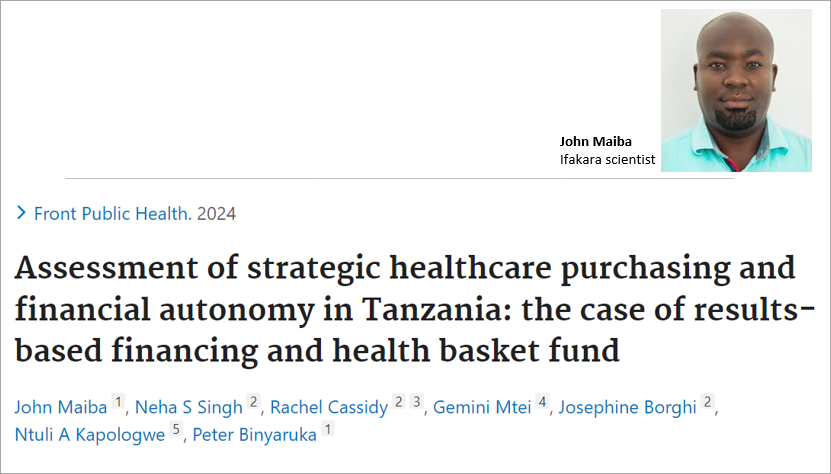
TANZANIA: Health financing reforms on track for universal health coverage

Tanzania has been making significant progress towards achieving Universal Health Coverage (UHC) through successful health financing reforms, as reported in a recent study conducted by the Ifakara Health Institute in collaboration with UK and Swiss institutions.
The study, published in the Frontiers in Public Health journal, demonstrates how Tanzania’s two key health financing programs – Results-Based Financing (RBF) and Direct Health Facility Financing through Health Basket Fund (DHFF-HBF), introduced in 2016 and 2017/18 respectively aligned with the principles of Strategic Health Purchasing (SHP).
“This is the first study to describe the SHP arrangements, purchaser providers split, and degree of financial autonomy between the DHFF-HBF and RBF schemes in Tanzania. Overall, we found purchasing arrangements of both schemes were largely aligned with SHP principles,” reported the scientist in their study.
What is strategic health purchasing?
Strategic Health Purchasing (SHP), recommended by the World Health Organization (WHO) in 2017 as a key principle guiding health financing reforms to accelerate progress toward universal health coverage, aims to enhance equity in resource distribution, increase efficiency, manage expenditure growth, and promote quality in health service delivery. It also strives to enhance transparency and accountability among providers and purchasers.
>>Learn more about Strategic Purchasing here.
The DHHF vs RBF schemes
In Tanzania, the DHFF-HBF scheme has been implemented in all public primary healthcare (PHC) facilities across all districts since 2017/18. The approach involves the direct transfer of pooled donor funds (Health Basket Funds, HBF) from the central government to public PHC facilities and selected non-public PHC facilities, allowing them to manage them independently to meet the needs of the population. The approach is designed to ensure reliable and timely disbursement of funds, promoting autonomy, transparency, and accountability at the PHC level.
Equally, the RBF scheme, implemented in nine regions between 2016–2020, focuses on performance-based payments to improve healthcare usage and quality. The scheme pays providers based on pre-defined performance indicators or targets in PHC facilities.
By reviewing documents and conducting interviews with health managers, providers, and national-level stakeholders, the scientists assessed the strategic purchasing functions, purchaser-provider split and financial autonomy within the DHFF-HBF and RBF financing programs in Tanzania.
DHFF, RBF schemes’ alignment with SHP principles
Both programs were found to generally align with SHP principles, demonstrating significant potential in enhancing the efficiency of fund allocation and expenditure for improved healthcare access and delivery in the country.
However, differences emerged between the two schemes. While the RBF scheme provides a clear and explicit provider-purchaser split and more autonomy on spending facility funds, the DHFF-HBF scheme fell short, facing budget constraints limiting flexibility on specific spending items. The distinction had an impact on the financial autonomy of providers, hindering their ability to respond effectively to service delivery needs.
Delving into these findings, Ifakara scientist and lead author of the study, John Maiba said; “The RBF scheme had a clear purchaser-provider split arrangement compared to a partial arrangement under the DHFF-HBF scheme. Study participants reported that the RBF scheme provided more autonomy on spending facility funds, while the DHFF-HBF scheme was less flexible due to a budget ceiling on specific spending items.”
SHP success in DHFF, RBF programs
The scientists underscore the success of SHP in these programs by highlighting its effectiveness in prioritizing services through explicit benefit packages, engaging both public and private healthcare providers through contractual agreements, and utilizing output-based payment methods.
“Both schemes follow the principles of strategic purchasing. In this regard, our study highlights that strategic purchasing can take different forms each with strengths and weaknesses. It is high time for Tanzania policymakers to capitalize on strategic and effective design elements of each scheme.”
Challenges in health financing
The study also highlights challenges faced by low- and middle-income countries (LMICs), particularly the government’s heavy reliance on donor funding for health services, leading to a fragmented funding landscape and multiple funding mechanisms. This often led to service duplication, increased reporting burden, and disparities in affordable healthcare access.
Addressing these challenges, the scientists recommend additional efforts to strengthen health financing reforms saying, “Both RBF and DHFF-HBF considered most of the strategic healthcare purchasing principles, but further efforts are needed to strengthen the alignment towards UHC.”
“These (efforts) may include further strengthening the data verification process and spending autonomy for DHFF-HBF, although it is important to contain costs associated with verification and ensuring public financial management around spending autonomy,” they added.
Implications for policymakers and researchers
With significant implications for policy and healthcare financing reforms, the scientists encourage Tanzanian policymakers to capitalize on the strengths of each scheme. In particular, they suggest improvements to the DHFF design based on lessons learned from the phasing out RBF scheme.
Moreover, they also underscore the evolving nature of these schemes, emphasizing the need for additional research to understand their impact on Tanzania’s journey toward UHC.
“Our study has important implications for both policy and research. Both schemes follow the principles of strategic purchasing. In this regard, our study highlights that strategic purchasing can take different forms each with strengths and weaknesses. It is high time for Tanzania policymakers to capitalize on strategic and effective design elements of each scheme.”
Ifakara scientists lead the study
This study was led by Ifakara Health Institute scientist John Maiba with contributions from Peter Binyaruka also from the same institution.
Other contributors include Neha Singh, Rachel Cassidy and Josephine Borghi from the London School of Hygiene and Tropical Medicine (LSHTM) in the UK, Gemini Mtei from the USAID Public Sector Systems Strengthening (PS3+) Project in Tanzania, and Ntuli Kapologwe from the Tanzania President's Office, Regional Administration, and Local Government Tanzania (PO-RALG).
Read the publication here.
